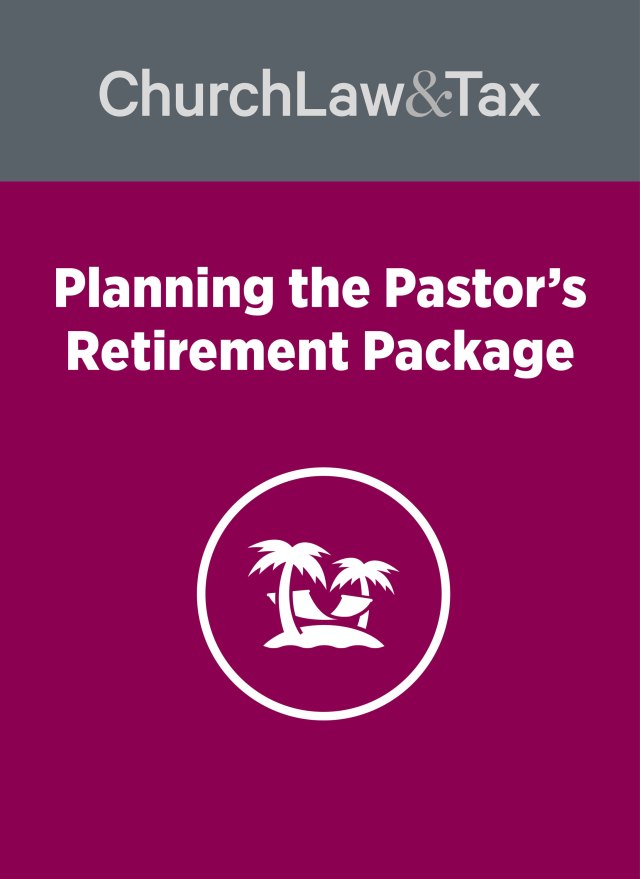The aptly-named Setting Every Community Up for Retirement Enhancement Act (SECURE 2.0) is designed to:
- increase retirement savings,
- simplify and clarify retirement plan rules and,
- encourage employees to contribute more to their retirement accounts.
Effective now
Mandatory distributions now set to begin at 73 (Section 107)
Also, Section 302 of SECURE 2.0 drops the required minimum distributions tax penalty from 50 percent to 25 percent for qualified plans. It drops even further (to 10 percent) if the failure to take a minimum distribution is corrected in a timely manner.
Stay informed! Consider an Advantage Membership with Church Law & Tax for access to in-depth information and analysis on topics confronting today’s church pastors and leaders.
Small—and immediate—financial incentives for contributing to a plan (Section 113)
While employers may provide matching contributions as a long-term incentive for employees to contribute to a retirement plan, they have not been allowed to offer immediate financial incentives for such activities.
SECURE 2.0 removes this barrier by allowing de minimis financial incentives, such as low-dollar gift cards, not paid for out of plan assets, to boost employee participation in 401(k) and 403(b) plans.
Penalty-free withdrawals for emergencies (Section 115)
SECURE 2.0 allows for once-a-year distributions from 401(k), 403(b), and Individual Retirement Account (IRA) plans of up to $1,000 for unforeseeable and/or immediate financial needs of a personal or family nature.
Taxpayers have up to three years to repay the money. While they’re repaying it, no additional emergency withdrawals are allowed.
Assisting states in locating owners of applicable savings bonds (Section 122)
Section 122 requires the Treasury Secretary to share certain relevant information with a state that relates to an applicable savings bond registered to an owner with a last known or registered address in that state.
The state can use that information to locate the registered owner in accordance with the state’s standards for recovery of abandoned property. Section 122 further requires the Treasury Secretary to develop guidance as may be necessary to carry out the proper disclosure and protection of such information.
Enhancement of 403(b) plans (Section 128)
403(b) plan investments were once generally limited to annuity contracts and publicly traded mutual funds to the detriment of charitable, public school, and college and university employees. Now, the law allows 403(b) custodial accounts to participate in group trusts with other tax-preferred savings plans and IRAs.
Retirement plan overpayment recovery (Section 301)
Retirement plan fiduciaries can now decide whether to recoup overpayments mistakenly made to retirees according to certain limitations and protections put in place to protect retirees.
Background: Through no fault of their own, retirees sometimes receive more money than they are owed under their retirement plans, which can cause problems when plan fiduciaries look to claw back those overpayments, with interest.
Updating dollar limits for mandatory distributions (Section 305)
- Allow more types of errors to be corrected internally through-self correction,
- Apply inadvertent IRA errors, and
- Exempt certain failures to make required minimum distributions from the otherwise applicable excise tax. For example, Section 305 allows for correction of many plan loan errors through self-correction, which are a frequent area of error and can be burdensome to correct a single loan error through the Internal Revenue Service (IRS).
Any guidance or revision of guidance required by Section 305 shall be made widely known no later than 2 years after the date of enactment of this Act. Revenue Procedure 2021–30 (or any successor guidance) shall be updated to take into account the provisions of this section no later than 2 years after the date of enactment of this Act.
Employees can now certify hardship distribution conditions (Section 312)
Employees in need of a hardship withdrawal from an eligible retirement plan can now, under certain circumstances, self-certify that they’re in need of the funds and have no other options available to meet the need.
Section 312 is effective for any plan year beginning after the date of the enactment of SECURE 2.0.
Tax treatment of IRA involved in a prohibited transaction (Section 322)
Section 322, Tax treatment of IRA involved in a prohibited transaction. When an individual engages in a prohibited transaction with respect to his or her IRA, the IRA is disqualified and treated as distributed to the individual, irrespective of the size of the prohibited transaction. Section 322 clarifies that if an individual has multiple IRAs, only the IRA with respect to which the prohibited transaction occurred will be disqualified.
Exception to withdrawal penalties for terminally ill individuals (Section 326)
Section 326 provides an exception to the 10 percent tax on early distributions from tax preferred retirement accounts in the case of a distribution to a terminally ill individual.
Effective after Dec. 31, 2023
Higher ‘Catch-Up’ limits for IRA contributions (Section 108)
The $1,000 limit on IRA contributions is to be indexed for individuals who have reached age 50 starting with taxable years that begin after Dec. 31, 2023.
Help for those struggling to save while paying student debt (Section 110)
SECURE 2.0 permits an employer to make matching contributions under a 401(k), 403(b), SIMPLE IRA, or 457(b) plan with respect to “qualified student loan payments.”
What is a “qualified student loan payment?” Broadly defined, it’s “any indebtedness incurred by the employee solely to pay qualified higher education expenses of the employee.”
Starter 401(k) plans for employers with no retirement plans (Section 121)
An employer that does not sponsor a retirement plan can offer either a starter 401(k) or safe harbor 403(b) plan that would generally require all employees to be default-enrolled anywhere from a 3- to 15-percent deferral rate. Annual deferrals are capped at $6,000, with another $1,000 available for catch-up contributions after age 50. Section 121 becomes effective for plan years beginning after Dec. 31, 2023.
Emergency savings accounts linked to individual account plans (Section 127)
Employers can offer pension-linked emergency savings accounts to employees earning less than $150,000 in the previous year.
They can also opt employees into these accounts at no more than 3 percent of an employee’s salary up to $2,500, at which time additional contributions can shift to the employee’s Roth-defined contribution plan.
Contributions are made on a “Roth-like” basis (contributions are taxed upon deposit, but future withdrawals are not taxed) and can be matched dollar-for-dollar up to $2,500.
Employees can then pull from the accounts no more than four times a year without fees or charges and, upon separation from service, employees can cash these accounts out or roll them into another plan.
Updating dollar limits for mandatory distributions (Section 304)
Section 304 allows employers to transfer former employees’ retirement accounts from a workplace plan into an IRA if the balance is between $1,000 and $7,000, effective for distributions made after Dec. 31, 2023. (The previous balance limit for such transfers was $5,000.)
Penalty-free withdrawals for domestic abuse victims (Section 314)
Section 314 allows penalty-free withdrawals from retirement plans for domestic abuse victims.
A domestic abuse survivor may need to access his or her money in their retirement account for various reasons, such as escaping an unsafe situation. Section 314 allows retirement plans to permit participants that self-certify that they experienced domestic abuse to withdraw a small amount of money (the lesser of $10,000, indexed for inflation, or 50 percent of the participant’s account).
A distribution made under Section 314 is not subject to the 10 percent tax on early distributions. Additionally, a participant may repay the withdrawn money from the retirement plan over 3 years. They can then receive refunded income taxes on money that is repaid.
New hardship withdrawal rules for 403(b) plans (Section 602)
Historically, distribution rules for 403(b) plans have been more restrictive than those of 401(k) plans. SECURE 2.0 conforms 403(b) distribution rules to less restrictive 401(k) rules.
Effective after Dec. 31, 2024
Expanding automatic enrollment in retirement plans (Section 101)
Many Americans reach retirement age with little or no savings because they don’t participate in employer-sponsored retirement plans or they aren’t offered ones in the first place.
Section 101 requires 401(k) and 403(b) plans to automatically enroll all eligible participants (who can then opt-out if they so choose).
There is an exception for church plans, small businesses with 10 or fewer employees, new businesses (i.e., those that have been in business for less than 3 years), and governmental plans.
The automatic enrollment amount is at least 3 percent but not more than 10 percent. It is set to increase by 1 percent each year until it reaches at least 10 percent, but not more than 15 percent.
All current 401(k) and 403(b) plans are grandfathered.
Higher ‘Catch-Up’ limits based on certain ages (Section 109)
Per section 109, maximum catch-up contributions starting in 2025 jump from $6,500 ($3,000 for SIMPLE plans) to the greater of either (a) $10,000, or (b) 50 percent more than the regular catch-up amount for those ages 60 to 63. Increased amounts will be indexed for inflation after 2025. This takes effect for taxable years beginning after Dec. 31, 2024.
Retirement savings lost and found (Section 303)
Section 303 creates a national online searchable lost and found database for Americans’ retirement plans at the US Department of Labor (DOL). The database will help those who have lost track of a pension or 401(k) plan a way to search for contact information of their plan administrator. The DOL has until the end of 2024 to create the database.
Effective on or after Jan. 1, 2025
Improving coverage for part-time workers (Section 125)
For plans years starting on or after Jan. 1, 2025, employers will be required to allow long-term, part-time workers to participate in 401(k) and 403(b) plans either after 1 year of service (with the 1,000-hour rule) or 2 consecutive years of service (where the employee completes at least 500 hours of service).
Long-term care contracts purchased with retirement plan distributions (Section 334)
Permits retirement plans to distribute up to $2,500 per year for the payment of premiums for certain specified, high-quality, long-term care insurance contracts.
Effective after Dec. 31, 2026
Saver’s Match (Section 103)
Prior law provided for a nonrefundable credit for certain individuals who make contributions to a 403(b) plan or some other retirement plans.
Section 103 repeals and replaces the credit. It changes it from a credit paid in cash as part of a tax refund into a federal matching contribution. This contribution must be deposited into a taxpayer’s retirement plan.
A few details about the match:
- It is 50 percent of retirement plan contributions up to $2,000 per individual.
- It phases out between $41,000 and $71,000 in annual income in the case of taxpayers filing a joint return ($20,500 to $35,500 for single taxpayers or those married filing separate, and $30,750 to $53,250 for head-of-household filers).
SECURE 2.0 also directs the Treasury Department to increase public awareness of the Saver’s Match to increase use of the match by low- and moderate-income taxpayers.

